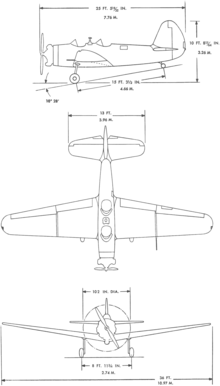
The Naval Aircraft Factory XN5N was a prototype United States monoplane trainer aircraft produced by the Naval Aircraft Factory in Philadelphia, Pennsylvania in 1941. A single prototype was built and evaluated.

The Waco Custom Cabins were a series of up-market single-engined four-to-five-seat cabin sesquiplanes of the late 1930s produced by the Waco Aircraft Company of the United States. "Custom Cabin" was Waco's own description of the aircraft which despite minor differences, were all fabric-covered biplanes.
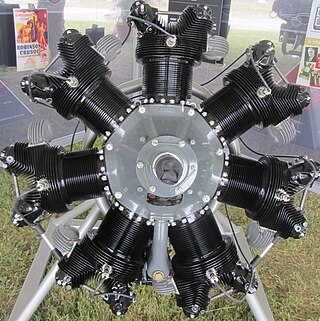
The Continental R-670 was a seven-cylinder four-stroke radial aircraft engine produced by Continental displacing 668 cubic inches and a dry weight of 465 lb (211 kg). Horsepower varied from 210 to 240 at 2,200 rpm. The engine was the successor to Continental's first radial engine, the 170 hp Continental A-70. This engine was used on many aircraft in the 1930s and 1940s. The R-670 was widely used in the PT-17 Stearman primary training aircraft of the U.S. military.
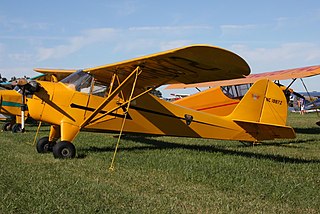
The Aeronca Model K Scout is an American light airplane first marketed in 1937, and was the true successor to the popular C-2/C-3 line.

The Culver Dart was a 1930s American two-seat light monoplane aircraft produced by the Dart Aircraft Company.

The Waco Aircraft Company (WACO) was an aircraft manufacturer located in Troy, Ohio, United States. Between 1920 and 1947, the company produced a wide range of civilian biplanes.

The Cessna Model A is a 1920s American high-wing four-seat tourer built by the Cessna Aircraft Company, the first in a long line of high-wing single-engined monoplanes.
The Kinner Sportster was a 1930s American light monoplane built by Kinner Airplane & Motor Corporation.

The FMA 20 El Boyero ("Shepherd") was a light utility aircraft produced in Argentina in the 1940s. It was a conventional high-wing strut-braced monoplane with a fixed tailskid undercarriage, seating two side by side in an enclosed cabin.
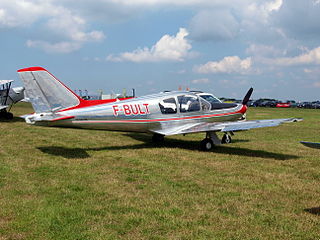
The Procaer F.15 Picchio is an Italian-designed light utility aircraft built by Procaer.

The Maule M-4 is an American four-seat cabin monoplane designed by Belford Maule and built by the Maule Aircraft Company.

The Maule M-5 is an American four-seat cabin monoplane designed and built by the Maule Aircraft Company.

The SECAN SUC-10 Courlis was a French high-wing touring monoplane designed and built by Société d'Etudes et de Construction Aéronavales (SECAN), a branch of the automobile company Société des Usines Chaussons. The aircraft had problems with the engine installation and only 144 were built, some without engines and were scrapped.
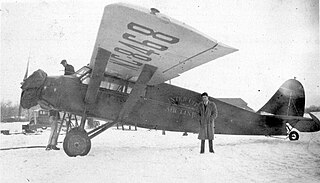
The Stinson Detroiter was a six-seat cabin airliner for passengers or freight designed and built by the Stinson Aircraft Syndicate, later the Stinson Aircraft Corporation. Two distinct designs used the Detroiter name, a biplane and a monoplane.
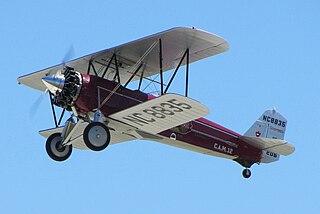
The Stearman C3 was an American-built civil biplane aircraft of the 1920s, designed by Stearman Aircraft of Wichita, Kansas. It was also the first Stearman aircraft to receive a type certificate.

The Waco F series is a series of American-built general aviation and military biplane trainers of the 1930s from the Waco Aircraft Company.

The Waco A series is a range of light American-built twin side-by-side seater sporting biplanes of the early 1930s.

The Waco Standard Cabin series is a range of American single-engine 4–5 seat fabric covered cabin biplanes produced by the Waco Aircraft Company beginning in 1931 with the QDC and continuing until 1942 when production ended for the VKS-7F. They were used as light passenger and utility transports, navigational trainers, bushplanes and briefly as maritime reconnaissance aircraft during World War 2.

The Eagle DW.1 is an American-built single-seat agricultural biplane of the late 1970s.
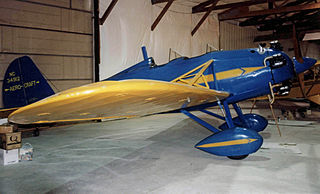
The Aerocraft 2AS is a tandem-seat training aircraft developed from the Kinner Sportwing.



